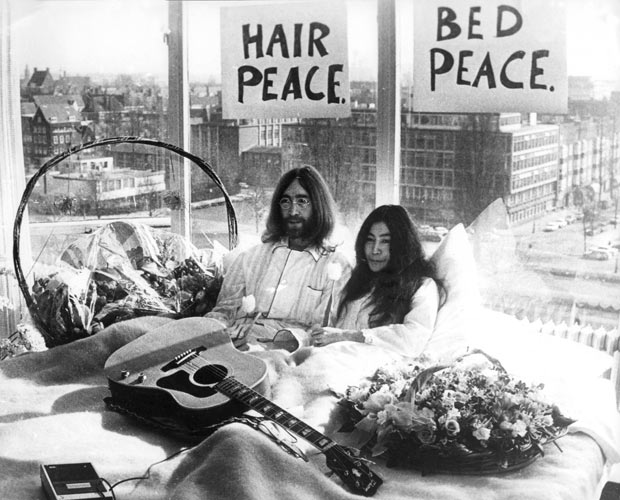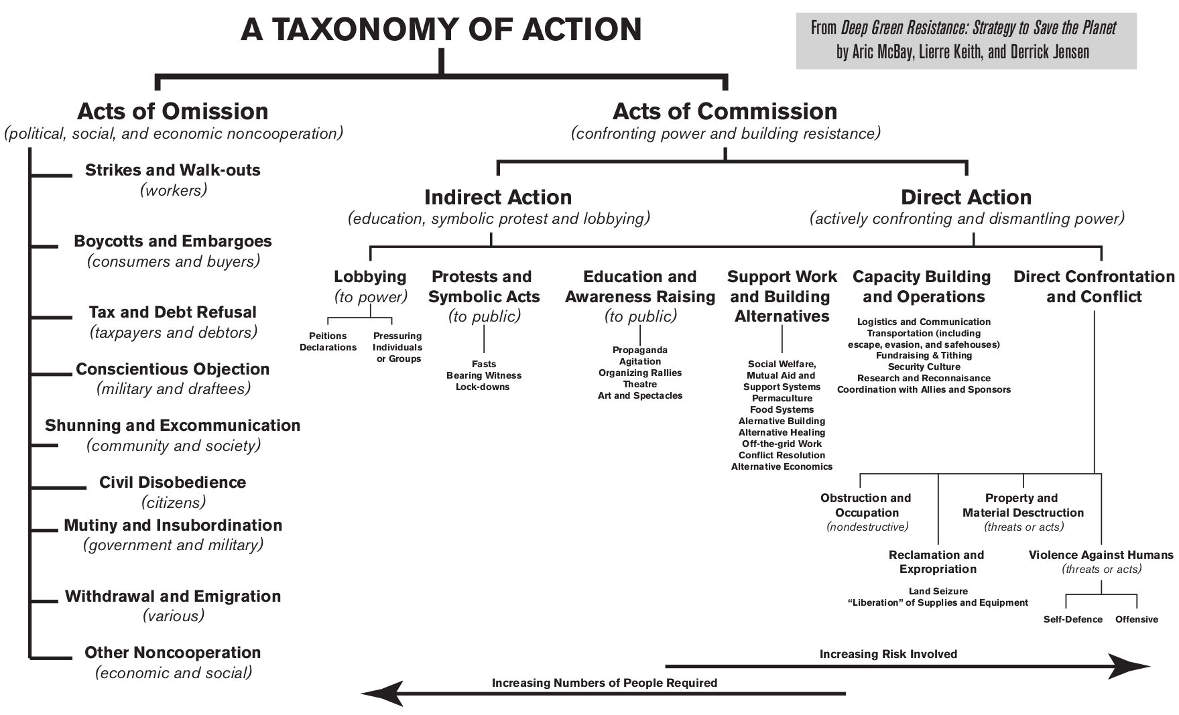This is the fifteenth installment in a multi-part series. Browse the Protective Use of Force index to read more.
This post will look at if nonviolence is effective and why it has become the default tactic of activists in industrialised countries. I’ll then conclude this run of posts on the problems of pacifism and nonviolence.
Is Nonviolence Effective?
Nonviolent resistance dominates most activist groups and campaigns in industrialised countries. If it were effective as a tactic, wouldn’t things be better than they are? Perhaps many nonviolent campaigns and movements do not adequately plan out their strategy and tactics. A number of nonviolence fundamentalists do state that nonviolence is powerless against extreme violence, [1] which is perhaps a good description of the society we live in.
Ward Churchill is clear that revolutionary strategy and tactics need to be tested to see if they’re able to achieve the goal of liberation. [2] If a critical assessment is not done, then there is a risk that the dogma of nonviolence takes precedence over achieving the goals that have been collectively set. [3]
Using pacifist and nonviolent methods self-restricts activists to a limited number of tactics and gives little chance of surprise. Their responses become predictable to the state. Those advocating force are not doing so because they want violence, but because our options are so limited that at times it’s necessary. [4] We need to use nonviolent tactics to resist but it’s not enough. We need the whole range of tactics to be available to us if we’re going have a chance of a livable planet (see the Taxonomy of Action image below, and a full page version here).
Why Has Nonviolence Become the Default Tactic of Activists in Industrialised Countries?
Nonviolence became popular during the civil rights and anti-war movements, and has now become the accepted method of challenging the state. Many radical activists have internalised the taboo around the use of force and go along with the generally accepted view that the use of force is wrong under any circumstances.
There has been little intellectual or practical effort to examine the nature of revolutions and what’s required to ensure they happen in industrialised countries. This has created a vacuum, which has been filled with the most convenient and readily available set of assumptions – pacifism or nonviolent resistance. [5] Gelderloos puts this shift down to the disappearance or institutionalisation of the social movements of the past. [6] The heavy involvement of NGOs, mass media, universities, wealthy benefactors, and governments has made a move towards “civil” resistance all but assured. [7]
Another very important factor that has caused nonviolence to become the most common tactic in mainstream activism is that it allows people to protest and campaign without too much risk to themselves. They can feel that they are doing something to alleviate their guilt about the way the world is run and the amount of suffering taking place. They can bear moral witness, posturing as decent people but actually being complicit in the crimes that they purport to oppose by not doing what it takes to win. This is also known as the “Good German Syndrome.” [8]
According to Derrick Jensen, claims that militant actions will threaten one’s own resistance are similar to death camp inmates employing different approaches to survival. In these camps, some want to make things more comfortable, and perceive those that want to escape as threats to those who want a bit more soap or food. This causes a “constriction in initiative and planning” in those inmates who have not been completely broken and approach the daily tasks of survival with ingenuity. Indirectly, their field of initiative is constantly narrowed by those in control. This relates to the lack of effectiveness of our current resistance to the state; many are captives of this culture who have not been completely “broken,” but have been traumatised to the point that their “field of initiative” has been consistently narrowed by the state. Prolonged trauma results in a reduction in active engagement in the world because the victim learns that they are being watched, that their actions will be thwarted, and that they will pay dearly for them. [9]
Churchill outlines a process of radical therapy with five phases to work through the pacifist problem.
- Values clarification, where the need for revolutionary social change is explained. The difference between needs based on reality or feeling is explored. The goal of this phase is to determine if the person’s values are consistent with revolutionary change or reform.
- Reality therapy, which involves direct and extended exposure to the lives of oppressed people in industralised and less industralised countries. Those undergoing therapy would live in these communities for extended periods of time, eating the food and getting by on an average income for that community.
- Evaluation, which is a period of guided and independent reflection upon the observation and experiences in “the real world.”
- Demystification, at this point participants will argue that militant resistance is necessary but may not want to engage in it themselves. They may have never handled weapons, so are scared of them. In this phase, they are trained how to use weapons. This stage is not about training guerrilla fighters, but rather showing the participants that they can learn these skills—that a weapon is simply a tool, although a powerful and dangerous one—and therefore that the decision to use force is a tactical one.
- Reevaluation, in this phase participants will be helped to articulate their overall perspective on the nature and process of “revolutionary social transformation,” which includes their understanding of what specific roles they might take in the process. [10]
Where does this leave us? Jeriah Bowser argues:
[There is an] incredible amount of misunderstanding, narrow-minded dogmatism, and animosity that I obverse with many resistance communities. No matter what the social issue at hand, I have almost always found the parties involved to be rigidly polarized on the issue of violence: is it an acceptable tool to use for resisting oppression or not?
I believe both camps have much to offer the other, but we must first look at ourselves and examine our own positions critically, seeing the ways in which we might limit our own cause through hypocrisy, ignorance, privilege, personal fears and insecurities, and a misunderstanding of historical events. Then we can begin to understand the other side of the position, see the reasons that many people have chosen the alternative option, and ultimately try to find truths within their position that we can echo and sympathize with. To fail to consider and understand the other is to consciously remain ignorant. [11]
I completely agree with Bowser that those advocating force and those advocating nonviolence need to learn from each other, work together in solidarity where we have the same aims. It is achieving our collective goals that is important, not the tactics we employ—assuming these tactics aim to defend life.
Nonviolence fundamentalists paint those who think it might be necessary to use force as evil; but they all want the same thing: a just, sustainable world. The choice between using non-violence or force is a tactical decision. Those who advocate for the use of force are not arguing for blind unthinking violence, but against blind unthinking nonviolence. [12]
People who care about living in that just, sustainable world need to truly commit to their passion and act in whatever way makes sense to them. It is up to each individual and community to decide how to resist. The ultimate arbiter should be effectiveness. It is not right for others to judge those who choose to use force in service of revolution, especially if they are white, male and privileged.
Ultimately, the choice is not between nonviolence or violence, but between action and inaction .
This is the fifteenth installment in a multi-part series. Browse the Protective Use of Force index to read more.
Endnotes
- Global Warming: Militarism and Nonviolence,The Art of Active Resistance, Marty Branagan, 2013, page 59
- Pacifism as Pathology, Ward Churchill, 1998, page 93/4
- Pacifism as Pathology, page 137
- Pacifism as Pathology, page 92-4
- Pacifism as Pathology, page 89
- e.g. anti-war movement, environmental movement
- Failure of Nonviolence, Peter Gelderloos, 2013, page 13-14
- Pacifism as Pathology, page 14
- Derrick Jensen is referencing trauma expert Judith Herman in Endgame Volume 2, Derrick Jensen, 2006 page 724-6
- Pacifism as Pathology, page 95-102
- Elements of Resistance: Violence, Nonviolence, and the State Paperback, Jeriah Bowser, 2015, page 38, read here
- Pacifism as Pathology, page 4
To repost this or other DGR original writings, please contact newsservice@deepgreenresistance.org


